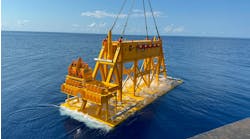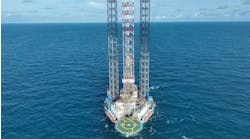Real-time well and reservoir monitoring systems
The Offshore Technology Conference has recognized new tool development in the field of well and reservoir monitoring systems as a Spotlight on New Technology.
“The Cableless Telemetry System (CaTS) by The Expro Group allows real-time information to be recovered from remote sensors using the available conducting (steel) well infrastructure, and without the use of dedicated cabling or instrument lines in the well,” says Dean Brown, Data Services Manager for Expro Americas Inc.
Its two-way transmission capability enables the remote control of downhole instrumentation, opening the path to the radical redesign of downhole completions.
A few features of interest include real-time data, two way communication, different sensor types, no cable to surface requirement for communications, minimal completion equipment penetrations, retro-fit through wireline conveyance and installation, and completion mandrel availability.
According to The Expro Group, “The system can be used in any well monitoring application where real-time data is required.” It can be run either in a completion mandrel or as a retrofit where it is conveyed and set on wireline. A wide range of applications in the monitoring of reservoir data was developed in the areas of long-term and quasi-permanent well and reservoir monitoring applications, artificial lift monitoring, monitoring of complex completions (multi-lateral, sandscreens, gravel packs, expandables), well interconnectivity monitoring, data transmission over surface and subsea pipelines, and monitoring, command, and control of completion, pipe, and wireline conveyed well completion and remedial equipment.
According to the company, “The published information www.exprogroup.com states that the system is fully configurable to be used with any sensor system.”
The standard system is the Quartzdyne resonating quartz pressure and temperature transducer. This is a transducer with excellent dynamic and long-term stability properties and is the de-facto standard for well and/or reservoir monitoring for both long and short-term applications, the company says.
“The steel in the well is used for the propagation of the electro-magnetic signal at extremely low frequencies,” The Expro Group says. This allows data to be sent over significant distances without the need for cables, electrical insulation of the completion, or the use of completion systems with special electrical properties.
The surface data pick-up can be at the wellhead or, in certain cases, some way downstream of the wellhead, within the flowline/gathering station complex. “This is clearly an advantage in areas with remote wellheads, and where it is desirable to minimize the value of equipment located on the wellhead,” the company says.
The limitation in depth can be overcome by the use of a downhole pick-up. This is a cable that is run into the well and grounded to the tubing/casing. Typically this might be run to the subsurface safety valve. The CaTS gauge then transmits between the gauge position and the downhole pick-up point. No additional electronics or repeaters are required.
According to the company, many appraisal susbsea wells are drilled and then abandoned without any long-term reservoir data being obtained. CaTS tools can be installed in the well after testing and then well suspended or abandoned in compliance with legislation. A seabed recorder box with an industry standard acoustic transmission system is installed on the wellhead. Data is then retrieved on demand by a surface vessel.
High-rate gas wells
In high-rate gas wells with large bore completions, it is often not possible to install permanent gauges close to the sand-face, the company says. As result they may be several thousand feet from the producing zones with associated friction and gravity impacts on the pressure readings. The company says that the mandrel style CaTS tools can be installed at the sand-face with a downhole pick-up at the permanent gauge point. The CaTS gauge then transmits to this downhole pick-up. The pressure measurements then obtained are used to calibrate the PMD system.
Reservoir management
Discussions on reservoir monitoring have traditionally tended toward offshore fields, since those are typically higher value investments and as such can justify greater resource allocation. The Expro Group says that nearly all-recent developments in monitoring or data acquisition technologies, such as permanent monitoring, fiber optic distributed temperature sensing, or 4D seismic have been driven by high value, high flow rate offshore wells. In spite of downhole permanent monitoring being accepted offshore for over 10 years, the number of installations onshore has been very limited.
However the fundamental principle of reservoir management remains the same, whether the wells are offshore or on land. A key component of reservoir management is obtaining the data to make the correct decisions; in other words - reservoir monitoring. At a time of rising commodity prices and increasing concerns about long-term deliverability and accurate reserves determination, this raises the question as to whether there is an economic case for improved reservoir monitoring.
According to the company, their wireless gauges present an alternative that has the potential to provide cost-effective surface read-out data. A wireless gauge can transmit pressure and temperature data from downhole without the need for cables, either permanent or temporary.
“Wireless technology is now field proven to depths in excess of 12,000 ft,” the company says. In addition to standard installations for monitoring reservoir pressure and temperature, the technology is finding new, non-standard applications in reservoir monitoring.




